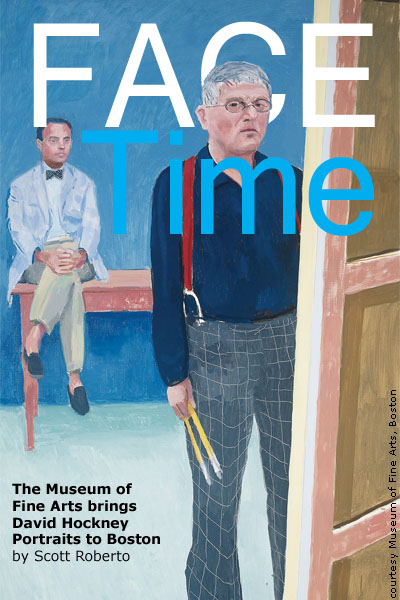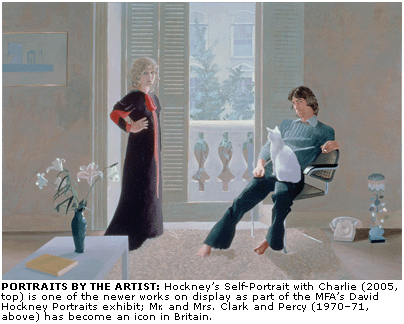 What is it that makes
a portrait memorable? Is it the skill of the artist? The subjects themselves?
Or is it something undefinable, some nameless inner essence that is captured,
connecting the sitter and painter for all time? Don't ask famed artist David
Hockney, the subject of the comprehensive retrospective David Hockney
Portraits at the Museum of Fine Arts.
What is it that makes
a portrait memorable? Is it the skill of the artist? The subjects themselves?
Or is it something undefinable, some nameless inner essence that is captured,
connecting the sitter and painter for all time? Don't ask famed artist David
Hockney, the subject of the comprehensive retrospective David Hockney
Portraits at the Museum of Fine Arts.
"I know to make memorable images," he stated at a recent press conference at
the MFA. "But we don't know how they're made. If they did, they'd be making a
lot of them."
Yet make a lot of them he has. Perhaps the secret to the English-born
California resident's success is his often intimate knowledge of his subjects.
"I've generally painted people I know quite well," Hockney revealed, "partly
because otherwise it seems you might struggle a bit for a likeness."
The prolific Brit-one of today's best-known artists-appears to have done just
fine in capturing the likenesses of friends, family, lovers and even himself in
mediums ranging from large-scale oil paintings to intimate drawings to
Cubism-influenced photographic collages.
The comprehensive show-the first portraits-only exhibition of Hockney's art to
date-spans five decades of his groundbreaking work. But don't get the idea that
the 68-year-old master has slowed down a bit. In fact, at an age when most
people are contemplating retirement, it would seem Hockney has become even more
productive, with more than three dozen of the 150-plus pieces on display having
been completed in the new millennium.
 The literal and figurative centerpieces of the show, however,
are several monumental double portraits from the 1970s. This includes the
now-ubiquitous Mr. and Mrs. Clark and Percy from 1970-71. The work is
a perfect example of Hockney's ability to encapsulate his subjects through the
use of subtle staging and body language, unconsciously revealing through the
figures' spatial relationship and poses a couple whose marriage was in decline.
On loan from London's Tate Gallery, it was voted one of the greatest paintings
in Britain in a national poll last year and was the only one by a living artist
to make the cut.
The literal and figurative centerpieces of the show, however,
are several monumental double portraits from the 1970s. This includes the
now-ubiquitous Mr. and Mrs. Clark and Percy from 1970-71. The work is
a perfect example of Hockney's ability to encapsulate his subjects through the
use of subtle staging and body language, unconsciously revealing through the
figures' spatial relationship and poses a couple whose marriage was in decline.
On loan from London's Tate Gallery, it was voted one of the greatest paintings
in Britain in a national poll last year and was the only one by a living artist
to make the cut.
Hockney himself seemed a little overwhelmed by his accomplishments. "I've never
seen 50 years of my work put together before," he said in awe, before adding in
typically dry English fashion, "I haven't been wasting my time." 
back to homepage